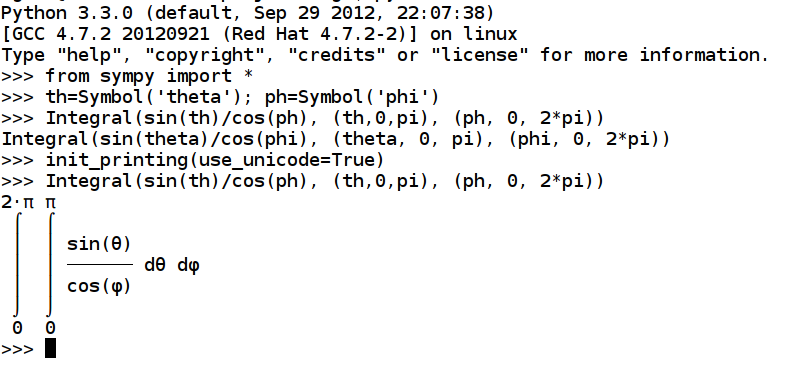forked from sympy/sympy
-
Notifications
You must be signed in to change notification settings - Fork 0
Pretty Printing
Amit Saha edited this page Jul 6, 2013
·
6 revisions
SymPy is able to display nice-looking formulas on a pure terminal using ascii-art. In addition, When Unicode is available, it uses special better-looking symbols for drawing.
To try it, run isympy in a unicode-capable terminal such as uxterm or gnome-terminal.
$ ./bin/isympy
IPython console for SymPy 0.7.1-git (Python 2.6.6-64-bit) (ground types: python)
These commands were executed:
>>> from __future__ import division
>>> from sympy import *
>>> x, y, z, t = symbols('x y z t')
>>> k, m, n = symbols('k m n', integer=True)
>>> f, g, h = symbols('f g h', cls=Function)
...
>>> from sympy import *
>>> f = Function('f')
>>> f(x/(y+1), y) #doctest: +USE_UNICODE
⎛ x ⎞
f⎜─────, y⎟
⎝y + 1 ⎠
>>> sqrt((sqrt(x+1))+1)
_______________
/ _______
\/ \/ x + 1 + 1
>>> from sympy import *
>>> th=Symbol('theta'); ph=Symbol('phi')
>>> Integral(sin(th)/cos(ph), (th,0,pi), (ph, 0, 2*pi)) #doctest: +USE_UNICODE
2⋅π π
⌠ ⌠
⎮ ⎮ sin(θ)
⎮ ⎮ ────── dθ dφ
⎮ ⎮ cos(φ)
⌡ ⌡
0 0
>>> Integral(x**2*sin(y), (x,0,1), (y,0,pi)) #doctest: +USE_UNICODE
π 1
⌠ ⌠
⎮ ⎮ 2
⎮ ⎮ x ⋅sin(y) dx dy
⌡ ⌡
0 0
>>> from sympy import Symbol
>>> Mul(*[Symbol('theta%i' %i) for i in range(1,5)]) #doctest: +USE_UNICODE
θ₁⋅θ₂⋅θ₃⋅θ₄
>>> Symbol('Y_00')(th,ph)**2 == 1/(4*pi)
False
>>> Matrix([
... [1/(4*pi), 1],
... [1, f(x)]
... ]) #doctest: +USE_UNICODE
⎡ 1 ⎤
⎢─── 1 ⎥
⎢4⋅π ⎥
⎢ ⎥
⎣ 1 f(x)⎦
gnome-terminal:
TBD
KDE Konsole
